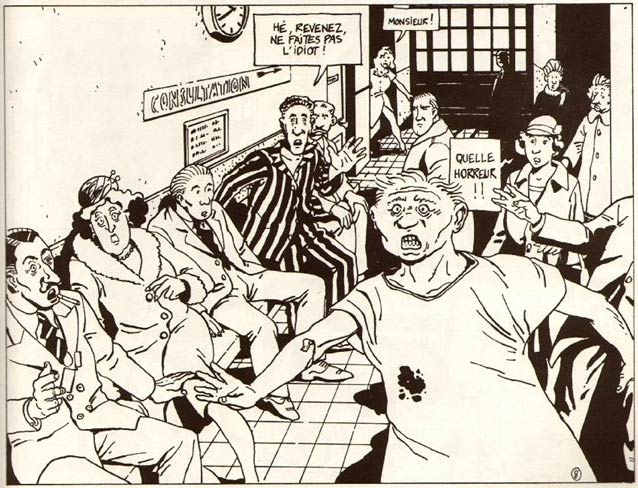Ted Benoît was a French comic book artist, and one of the main representatives of the Clear Line revival of the 1980s. He is best known for creating the film noir pastiche 'Ray Banana' (1977), and for reviving the classic 'Blake & Mortimer' series with Jean Van Hamme.
Early life and career
He was born in 1947 as Thierry Benoît in Niort, France, and studied Cinematography at the Institute for Advanced Cinematographic Studies (I.D.H.E.C.). He began his career as an assistant producer for French television. In 1971, he joined the editorial team of Actuel, an alternative magazine in which he also published his first comics. Upon meeting Nikita Mandryka in 1975, Benoît started contributing to L'Écho des Savanes (1976-1978). His work also appeared in Geranonymo (1975), Métal Hurlant (from 1976), Libération and À Suivre, and he made his album debut at Les Humanoïdes Associés in 1979 with 'Hôpital'.
'Hôpital'
Ray Banana
While Benoît's early work was influenced by the underground comix movement, Benoît became a prominent representative of the Clear Line style, which was established by Hergé and Edgar P. Jacobs in the 1940s. With artists like François Avril, Philippe Petit-Roulet, Philippe Dupuy, Charles Berbérian and Jacques de Loustal, he formed to so-called École de Pigalle, a group of artists from the Paris-area who were heavily influenced by the Clear Line style of Yves Chaland and the pictoral work of Gus Bofa. Benoît manifested his Clear Line work with the album 'Vers la Ligne Claire' (Les Humanoïdes Associés, 1981), a collection of his short stories for magazines like Libération and Métal Hurlant, and homage to artists like Hergé and Joost Swarte. It featured his trademark character 'Ray Banana', a playboy with Ray-Ban sunglasses and the looks of Clark Gable, who had made his first appearance in L'Écho des Savanes in 1977.
Ray Banana - 'Morfeu Electrico'.
With his 'Ray Banana' stories, Benoît crafted a retro-style artificial universe, filled with references to the archetypes of the American way of life. Longer stories with Benoît's anti-hero appeared in the montly magazine À Suivre from 1980 on, and were published in the books 'Berceuse Électrique' (1982) and 'Cité Lumière' (1986) by Casterman. The memoires of Ray Banana's cleaning lady, an alternate version of the real-life actress Thelma Ritter (1902-1969), were the subject of the book 'L'Homme de Nulle Part' (Casterman, 1989), for which Ted Benoît wrote the script, but left the artwork to Pierre Nedjar. Benoît's character was also featured in 'L'Homme Qui Ne Transpirait Pas', a novel written by Philippe Paringaux (Reporter, 1994).
Short stories
The short stories Benoît made for À Suivre with Yves Cheraqui were collected in the book 'Histoires Vraies' by Les Humanoïdes Associés in 1982. In 1981, Benoît had made the illustrations for the book 'Dans les Griffes de l'Ombre Rouge', dedicated to the film 'L'Ombre Rouge' of the French film director Jean-Louis Comolli, and published by Les Cahiers du Cinéma. His comic 'Bingo Bingo et son Combo Congolais' appeared in Métal Hurlant and Métal Aventures in 1987, and was published in book format by Les Humanoïdes the same year.
'Histoires Vraies'.
Blake & Mortimer
By the early 1990s, Ted Benoît had proved himself a master of the Clear Line. It was not a surprise that he was picked out to take care of the revival of the classic 'Blake & Mortimer' comic with scriptwriter Jean Van Hamme, after their creator Edgar P. Jacobs had passed away in 1987. Benoît and Van Hamme brought back Jacobs' British scientist and MI5 captain for the first time in the espionage story 'L'Affaire Francis Blake' ('The Francis Blake Affair', 1996), published by Éditions Blake et Mortimer. While Yves Sente and André Juillard were hired to create additional new stories, Benoît and Van Hamme returned to the characters with the more science fiction-oriented story 'L'Étrange Rendez-Vous' ('The Strange Encounter', 2001). Benoît was perhaps to a too meticulous artist to be productive for comics. Van Hamme thus made his new 'Blake & Mortimer' stories with René Sterne and Antoine Aubin, while Benoît focused on making illustrations and advertising art.
Graphic contributions
In 1983, Benoît was one of many comic artists paying homage to the recently deceased Hergé in a special issue of (À Suivre), titled 'Adieu Hergé'.
Final years and death
In his many portfolios, prints and posters, Benoït continued to experiment with new subjects and techniques. He wrote a comic adaptation of the Raymond Chandler detective thriller 'Playback', drawn by François Ayroles and published by Denoël Graphic in 2004. Ted Benoît passed away on 30 September 2016, at the age of 69.







